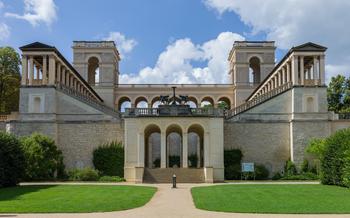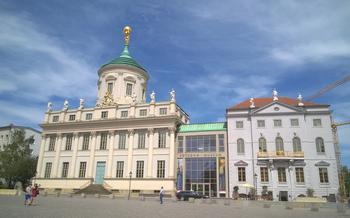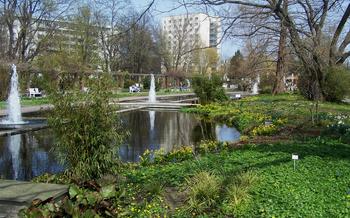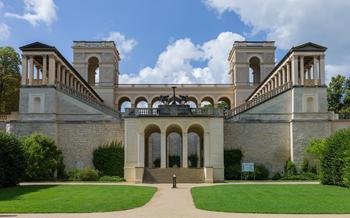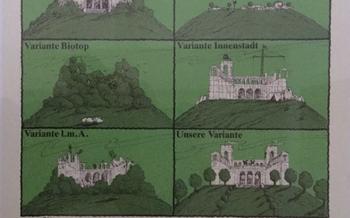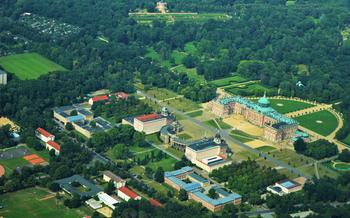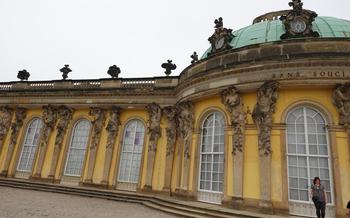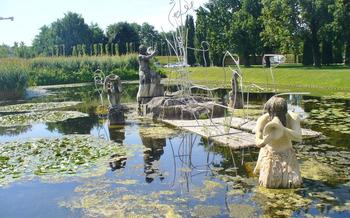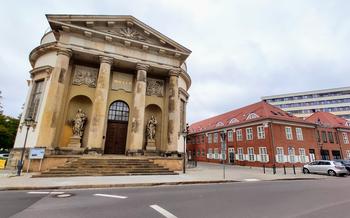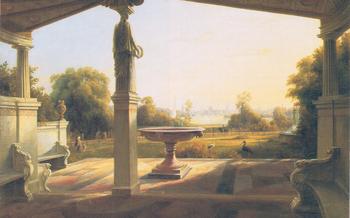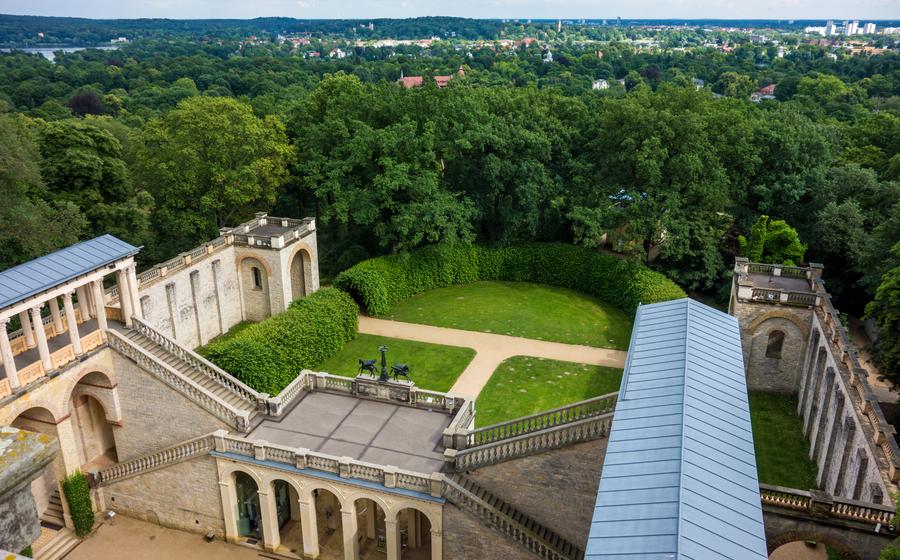
The Belvedere on the Pfingstberg in Potsdam
- The Belvedere on the Pfingstberg:
- A Royal Retreat
- Panoramic Views
- Exploring the Park
- Insider Tip:
- Art and Architecture
- The Marble Hall
- The Tower
- Royal Apartments
- Changing Exhibitions
- Café and Restaurant
- Accessibility
- Souvenirs and Gifts
- Insider Tip: Unveiling a Hidden Gem
The Belvedere on the Pfingstberg:
Nestled atop the scenic Pfingstberg hill in Potsdam, Germany, stands the Belvedere on the Pfingstberg, an architectural masterpiece that has captured the hearts and imaginations of visitors for centuries. This elegant palace, commissioned by King Frederick William IV of Prussia, serves as a testament to the grandeur and artistry of the Prussian monarchy. With its breathtaking panoramic views of Potsdam and Berlin, exquisite interiors, and meticulously landscaped gardens, the Belvedere offers a unique and unforgettable experience for travelers seeking a glimpse into the rich history and culture of Germany.
Location of the Belvedere and how to get there:
Situated just a short distance from the bustling city center of Potsdam, the Belvedere is easily accessible by public transportation. Visitors can take the S-Bahn (suburban train) to the Potsdam-Sanssouci station and then catch a short bus ride to the Pfingstberg hill. Alternatively, a leisurely walk through the picturesque Sanssouci Park offers a scenic route to the Belvedere, allowing visitors to immerse themselves in the natural beauty of the surroundings.
History of the Belvedere:
The Belvedere's story begins in the mid-19th century when King Frederick William IV commissioned the construction of a summer residence that would reflect his passion for art, architecture, and nature. Inspired by the Italian Renaissance, the king envisioned a palace that would harmonize with the surrounding landscape, offering panoramic views of the region. The renowned architect Ludwig Persius brought the king's vision to life, creating a masterpiece that has stood the test of time.
Architectural style of the Belvedere:
The Belvedere showcases an eclectic mix of architectural styles, blending elements of Italian Renaissance, Romanticism, and Neoclassicism. The palace's exterior is characterized by its symmetrical facade, adorned with intricate carvings, statues, and balconies. The interior boasts lavishly decorated rooms, each with its own unique character, reflecting the artistic tastes and preferences of King Frederick William IV.
A Royal Retreat
The Belvedere on the Pfingstberg served as a summer residence for the Prussian royalty, providing a serene escape from the bustling city of Berlin. Its close proximity to the Sanssouci Palace, the summer palace of Frederick the Great, further enhanced its significance as a royal retreat.
Panoramic Views
The Belvedere on the Pfingstberg is renowned for its breathtaking panoramic views of Potsdam and Berlin. Perched atop the hill, the Belvedere offers visitors a bird's-eye perspective of the surrounding landscape, including the Sanssouci Palace, the Glienicke Bridge, and the Havel River. The park's lush greenery and meticulously landscaped gardens further enhance the panoramic vistas, creating a picturesque backdrop for visitors to admire.
The best time to visit the Belvedere for optimal views is during the golden hours of sunrise and sunset. As the sun rises or sets, the sky transforms into a canvas of warm hues, casting a magical glow over the surrounding landscape. The Belvedere's elevated position allows visitors to witness this natural spectacle and capture stunning photographs of the panoramic vistas.
Whether you're a photography enthusiast, a nature lover, or simply seeking a tranquil escape, the Belvedere on the Pfingstberg offers an unforgettable experience with its breathtaking panoramic views. Take your time to soak in the beauty of the surroundings, marvel at the architectural grandeur of the Belvedere, and cherish the memories created in this enchanting setting.
Exploring the Park
The Belvedere on the Pfingstberg is nestled amidst the picturesque Pfingstberg Park, which is an integral part of the overall experience. The park offers a tranquil oasis with its lush greenery, meandering paths, and stunning views. One of the highlights of the park is the rose garden, featuring a vibrant display of colorful roses in bloom during the summer months. The park also boasts several water features, including a cascading fountain and a tranquil pond, which add to the serene atmosphere.
As you stroll through the park, you'll discover hidden gems and charming spots that offer unique perspectives of the Belvedere. One such spot is the Philosophenweg (Philosopher's Path), a winding path that leads you through a tranquil forest, offering glimpses of the Belvedere through the trees. Another must-visit spot is the Aussichtspunkt (Viewpoint), which provides breathtaking panoramic views of Potsdam and the surrounding countryside.
The history of the park is closely intertwined with that of the Belvedere. It was originally designed as a landscape park in the 19th century, following the principles of the English garden style. The park was intended to complement the Belvedere, providing a harmonious setting for the summer residence of the Prussian royalty. Over the years, the park has undergone several transformations, but it retains its original charm and elegance.
Insider Tip:
For a unique perspective of the Belvedere, head to the Philosophenweg (Philosopher's Path) in the Pfingstberg Park. As you walk along the path, you'll catch glimpses of the Belvedere through the trees, creating a picturesque and enchanting scene. The best time to visit the Philosophenweg is in the late afternoon when the sunlight filters through the leaves, casting a golden glow on the Belvedere.
Art and Architecture
The Belvedere on the Pfingstberg stands as a testament to the artistic and architectural achievements of its time. The collaboration between renowned artists and architects, including Ludwig Persius, Friedrich Wilhelm IV, and Johann Heinrich Strack, resulted in a masterpiece that seamlessly blends Italian Renaissance influences with Prussian Romanticism. The exterior façade of the Belvedere is adorned with intricate carvings, sculptures, and decorative elements, showcasing the exceptional craftsmanship of the period. Inside, visitors are captivated by the opulent interiors, featuring grand ballrooms, elegant salons, and private chambers adorned with exquisite paintings, tapestries, and furnishings. The Marble Hall, in particular, exemplifies the fusion of art and architecture, with its stunning marble columns, intricate stucco work, and magnificent ceiling frescoes. The Belvedere's harmonious blend of artistic styles and architectural finesse creates a truly immersive and awe-inspiring experience for visitors.
The Marble Hall
The centerpiece of the Belvedere is undoubtedly the magnificent Marble Hall, a testament to the exquisite craftsmanship and artistry that went into the palace's construction. Constructed using precious Carrara marble, the hall exudes an aura of grandeur and elegance. Its walls are adorned with intricate carvings, delicate moldings, and shimmering gold accents, creating a breathtaking visual spectacle.
The Marble Hall served as the grand ballroom of the Belvedere, hosting lavish royal events, receptions, and celebrations. It was here that the Prussian monarchs and their guests danced the night away, surrounded by the opulent splendor of the hall. The hall's acoustics were designed to enhance the musical performances that accompanied these gatherings, ensuring that every note resonated throughout the space.
One of the most striking features of the Marble Hall is its awe-inspiring ceiling, a masterpiece of Baroque artistry. The ceiling is adorned with a breathtaking fresco depicting scenes from Greek mythology, painted by the renowned artist Carl Begas. The vibrant colors and intricate details of the fresco bring the mythological figures to life, creating a sense of movement and drama that captivates the viewer.
The Marble Hall is not only a testament to the artistic prowess of its creators but also a symbol of the opulence and extravagance of the Prussian monarchy. It stands as a reminder of a bygone era, when royalty lived in splendor and grandeur, surrounded by the finest works of art and architecture.
The Tower
The Belvedere's iconic tower is a prominent landmark that defines the palace's silhouette against the Potsdam skyline. Soaring high above the surrounding landscape, the tower offers breathtaking panoramic views that extend far beyond the palace grounds. Its strategic location atop the Pfingstberg hill makes it an ideal vantage point, allowing visitors to survey the sprawling city of Potsdam, the tranquil waters of the Havel River, and the distant spires of Berlin.
The tower's history is closely intertwined with that of the Belvedere itself. Designed by Ludwig Persius and constructed between 1847 and 1848, the tower was conceived as an integral part of the palace's overall composition. Its architectural style mirrors that of the Belvedere, blending elements of Italian Renaissance and Neoclassical design. The tower's exterior is adorned with intricate carvings, decorative friezes, and arched windows that complement the palace's elegant facade.
Inside the tower, a winding staircase leads visitors to the observation deck, where they are rewarded with unobstructed views that stretch for miles in every direction. The surrounding landscape unfolds like a picturesque tapestry, with lush forests, shimmering lakes, and rolling hills creating a breathtaking panorama. On a clear day, it is even possible to catch a glimpse of the iconic Brandenburg Gate, standing sentinel in the heart of Berlin.
In addition to its panoramic vistas, the tower also boasts several architectural features that make it a unique and captivating structure. The tower's base is surrounded by a series of arched openings that allow light to filter through, creating a dramatic chiaroscuro effect. The tower's pinnacle is adorned with a delicate filigree of ironwork, reminiscent of the intricate metalwork found in Gothic architecture.
Overall, the Belvedere's tower is not just a functional viewpoint but an architectural masterpiece that enhances the palace's grandeur and adds to its visual appeal. Whether ascending the winding staircase or marveling at the panoramic vistas from the observation deck, visitors to the Belvedere will find that the tower is an unforgettable experience that encapsulates the palace's rich history and architectural splendor.
Royal Apartments
Step into the private realm of Prussian royalty as you explore the lavish royal apartments within the Belvedere. These opulent living quarters offer a glimpse into the lives of the former inhabitants of this grand palace. Admire the exquisite furnishings, intricate decorations, and personal touches that adorned these spaces, creating an atmosphere of grandeur and elegance.
Imagine yourself walking through the grand halls and chambers, each one adorned with opulent chandeliers, ornate tapestries, and gleaming marble fireplaces. The bedrooms exude a sense of regal comfort, with plush beds draped in rich fabrics and surrounded by intricate carvings. The dining rooms are fit for royalty, with long mahogany tables set with fine china and crystal, evoking the grandeur of formal banquets and intimate gatherings.
Discover the stories and secrets that lie within these walls, where the Prussian monarchs once resided, entertained guests, and made decisions that shaped the course of history. Whether it's the tales of lavish parties, political intrigue, or the private lives of the royal family, the royal apartments offer a fascinating glimpse into the world of Prussian nobility.
Changing Exhibitions
The Belvedere is not just a historical landmark; it also serves as a vibrant cultural hub, hosting a variety of temporary art exhibitions throughout the year. These exhibitions showcase the works of both established and emerging artists, providing a platform for contemporary art and culture to flourish. The themes and styles of these exhibitions vary widely, encompassing everything from modern paintings and sculptures to installations and photography.
One of the highlights of the Belvedere's exhibition program is the annual "Summer Exhibition," which features a diverse range of artworks created specifically for the Belvedere's unique spaces. This exhibition is a must-see for art enthusiasts and offers a glimpse into the latest trends and innovations in contemporary art.
To enhance your visit, consider planning your trip around a specific exhibition that interests you. The Belvedere's website provides up-to-date information on current and upcoming exhibitions, allowing you to tailor your visit to your artistic preferences. Whether you're a seasoned art collector or simply looking to appreciate the beauty and creativity of contemporary art, the Belvedere's changing exhibitions offer something for everyone.
Café and Restaurant
After exploring the Belvedere's grandeur, indulge in a culinary journey at the charming café and restaurant nestled within its historical walls. Savor a delightful menu featuring regional specialties and international favorites, carefully crafted to complement the Belvedere's ambiance.
The outdoor seating area invites you to bask in the warmth of the sun while enjoying picturesque views of the surrounding landscape. Sip on a refreshing beverage or relish a leisurely meal amidst the tranquil atmosphere of the Pfingstberg Park.
For a truly unforgettable experience, reserve a table at the Belvedere's restaurant for an evening of fine dining. As darkness descends, the Belvedere's illuminated facade casts a magical glow, creating an enchanting setting for a memorable dining experience.
Accessibility
The Belvedere and Pfingstberg Park are committed to ensuring that all visitors, regardless of their abilities, can fully experience and appreciate the site's beauty and history. Wheelchair-accessible entrances, ramps, and elevators are available throughout the Belvedere, allowing visitors with mobility challenges to navigate the building with ease. The park also features paved pathways, making it accessible for wheelchairs and strollers.
For visitors who require additional assistance, the Belvedere offers a range of services. Trained staff members are available to provide wheelchairs upon request and assist visitors with any mobility needs. Visitors can also book a guided tour specifically designed for individuals with disabilities, ensuring that they receive a comprehensive and inclusive experience.
To ensure a smooth and enjoyable visit, visitors with disabilities are encouraged to contact the Belvedere in advance to discuss their specific requirements. The staff is dedicated to providing any necessary accommodations and making the Belvedere accessible and welcoming to all.
Souvenirs and Gifts
The Belvedere houses a charming gift shop that offers a diverse selection of souvenirs and gifts to commemorate your visit. From postcards and magnets featuring stunning views of the palace and park to unique replicas of historical artifacts, there's something for everyone. You can also find books on the history and architecture of the Belvedere, as well as art prints and other decorative items inspired by its rich heritage.
For a truly special memento, consider purchasing a piece of jewelry or homeware inspired by the Belvedere's design and motifs. These exquisite items, crafted with meticulous attention to detail, make for cherished keepsakes that will remind you of your time spent in this enchanting place.
Insider Tip: Keep an eye out for limited-edition items and seasonal collections that capture the essence of the Belvedere in unique and creative ways. These exclusive offerings are sure to become collector's items, so don't miss your chance to own a piece of history.
Insider Tip: Unveiling a Hidden Gem
Beyond the manicured gardens and grand architecture of the Belvedere, a secret spot awaits discovery within the Pfingstberg Park. Nestled amidst the lush greenery, this hidden viewpoint offers a unique perspective of the Belvedere, revealing its grandeur from a secluded angle.
To find this hidden gem, venture into the park and follow the winding paths that lead away from the main attractions. As you wander deeper into the tranquil surroundings, keep an eye out for a discreet path that branches off to the left. This path will guide you to a secluded clearing, where the Belvedere emerges as a majestic centerpiece framed by towering trees.
The best time to visit this hidden spot is during the golden hour, when the setting sun casts a warm glow upon the landscape. As the sky transforms into a canvas of vibrant hues, the Belvedere stands bathed in an ethereal light, creating a magical ambiance that is sure to leave a lasting impression.
This secret viewpoint holds a special significance in relation to the Belvedere's history and design. It offers a glimpse into the architect's intent to create a harmonious relationship between the palace and its natural surroundings. From this vantage point, visitors can fully appreciate how the Belvedere blends seamlessly into the landscape, becoming an integral part of the picturesque Pfingstberg Park.
Whether you're a seasoned traveler or a local seeking hidden gems, this secret spot promises an unforgettable experience. Immerse yourself in the tranquility of the park, discover the Belvedere from a new perspective, and create lasting memories that will forever be etched in your mind.
